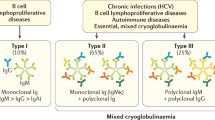Summary
The high frequency of liver involvement in cryoglobulinemia is well established. Although both etiology and pathogenesis have remained so far undefined, recent studies suggest an association of mixed cryoglobulinemia with hepatitis C virus infection. To explore this hypothesis further, we assessed the prevalence of hepatitis C virus antibodies and RNA in a large group of patients, including: (1) 35 patients with cryoglobulinemia without clinical evidence of liver involvement (group 1), (2) 15 patients with symptomatic cryoglobulinemia associated with chronic liver disease (group 2) and (3) 13 patients with asymptomatic cryoglobulinemia associated with chronic liver disease (group 3). Anti-hepatitis C virus antibodies were detected by a second-generation enzyme-linked immunosorbent assay and third-generation immunoblot (SIA Prototype RIBA), whereas the polymerase chain reaction was used for the detection of viral RNA Anti-hepatitis C virus antibodies, as detected by enzyme-linked immunosorbent assay, were demonstrated in 21 (60%) patients from group 1, 11 (73,3%) from group 2 and 10 (83.3%) from group 3. The immunoblot identified as positive 3 further patients in group 1 (giving a prevalence of 68.6%) and all patients in groups 2 and 3. Hepatitis C virus RNA was demonstrated in cryoprecipitates from 21 of 24 immunoblot-positives and from 6 of 11 immunoblot-negatives, indicating an actual active viral replication in 77.1% of group 1. This was also found in 13 (86.7%) and 10 (83.3%) cryoprecipitates was the prevalent form in group 1 (88.6%) and group 2 (73.3%), whereas type III was found in group 3 (58.3%) and in 26.7% of group 2. Type I cryoglobulins were found only in group 1 and were negative for hepatitis C virus antibodies and RNA. Hepatitis B virus markers indicating a chronic carrier state were found in 3 patients, 2 of whom were also infected with hepatitis C. It is concluded that mixed cryoglobulinemia is very commonly associated with active hepatitis C infection. The presence of hepatitis C virions and likely virus antigen-antibody complexes in cryoprecipitates strongly suggests a causative role of this virus in the pathogenesis of tissue damage and indicates that the term “essential,” which usually defines a major proportion of types II and III cryoglobulins, should be abandoned.
Similar content being viewed by others
References
Agnello V, Arbertter A, Ibanez de Kasep G, Powell R, Tan EM, Joslin F, Evidence for a subset of rheumatoid factors that cross-react with DNA-histone and have a distinct cross-idiotype. J Exp Med 151: 1514, 1980
Barnes JL, Goñi F, Heyermann H, Frangione B, Agnello V, Human rheumatoid factor cross-idiotypes. III. Bla monoclonal rheumatoid factor, prototype of the BLA cross-idiotype group, has distinct kappa chains related to the VkIII subgroup and VH4 heavy chains. Arthritis Rheum 33: 1710, 1990
Brouet JC, Clauvel JP, Danon F, Klein M, Seligmann M, Biologic and clinical significance of cryoglobulins: a report of 86 cases. Am J Med 57: 775, 1974
Dammacco F, Bonomo L Crioglobulinemia e piroglobulinemia. In: Dammacco F (ed) Immunologia in medicina. Eoli Ermes, Milan, pp 599–619, 1989
Dammacco F, Sansonno D, Antibodies to hepatitis C virus in essential mixed cryoglobulinemia. Clin Exp Immunol 87: 352, 1992
Duran JM, Lefèvre P, Harle JR, Boucrat J, Vitvitski L, Soubeyrand J. Cutaneous vasculitis and cryoglobulinemia type II associated with hepatitis C virus infection. Lancet 337: 499, 1991
Ferri C, Greco F, Longobardo G, Palla P, Moretti A, Marzo E, Mazzoni A, Pasero G, Bombardieri S, Highfield P, Corbishley T, Association between hepatitis C virus and mixed cryoglobulinemia. Clin Exp Rheumatol 9: 621, 1991
Fiorini G, Bernasconi P, Sinico RA, Chianese R, Pozzi F, D’Amico G, Increased frequency of antibodies to ubiquitous viruses in essential mixed cryoglobulinemia. Clin Exp Immunol 64: 65, 1986
Fiorini GF, Sinico RA, Winearls C, Custode P, De Giuli-Morghen C, D’Amico G, Persistent Epstein-Barr virus infection in patients with type II essential mixed cryoglobulinemia. Clin Immunol Immunopathol 47: 262, 1988
Galli M, Careddu F, D’Arminio A, Monti G, Messina K, Invernizzi F, Cryoglobulinemia and liver involvement. Ric Clin Lab 16: 367, 1986
Grey HM, Kohler PF, Cryoglobulins. Semin Hematol 10: 87, 1973
Jori GP, Buonanno G, Chronic hepatitis and cirrhosis of the liver in cryoglobulinemia. Gut 13: 610, 1972
Levo Y, Gorevic PD, Kassab HJ, Tobias H, Franklin EC, Liver involvement in the syndrome of mixed cryoglobulinemia. Ann Intern Med 87: 287, 1977
Levo Y, Gorevic PD, Kassab HJ, Zucker-Franklin D, Franklin EC, Association between hepatitis B virus and essential mixed cryoglobulinemia. N Engl J Med 296: 1501, 1977
McFarlane IG, Immunological abnormalities and hepatotropic viral infections. Clin Exp Immunol 87: 337, 1992
Nardi G, Zanchetta N, Ragni MC, Saracco A, Castagna A, Galli M, Viral antibodies in serum and cryoprecipitate of patients with essential mixed and secondary cryoglobulinemia. Preliminary results. Ric Clin Lab 16: 345, 1986
Pascual M, Perrin L, Giostra E, Schifferli JA, Hepatitis C virus in patients with cryoglobulinemia type II. J Infect Dis 162: 569, 1990
Pechère-Bertschi A, Perrin L, De Saussure P, Widmann JJ, Giostra E, Schifferli AJ, Hepatitis C: a possible etiology for cryoglobulinemia type II. Clin Exp Immunol 89: 419, 1992
Popp JW, Dienstag JL, Wands JR, Bloch KJ, Essential mixed cryoglobulinemia without evidence for hepatitis B virus infection. Ann Intern Med 92: 379, 1980
Sansonno D, Dammacco F, Antibodies to hepatitis C virus in non-A, non-B post-transfusion and cryptogenetic chronic liver disease. Lancet II: 798, 1989
Shimizu YK, Iwamoto A, Hijikata M, Purcell RH, Yoshikura H, Evidence for in vitro replication of hepatitis C virus genome in a human T-cell line. Proc Natl Acad Sci USA 89: 5477 1992
Shunji M, Yuji H, Kiyoshi T, Akira Y, Tohru G, Kazvaki T, Yoshihiro A, Hiroshi Y, Hiroaki O Fumio T, Peterson DA, Muchmore E, Non-A, non-B hepatitis specific antibodies directed at host-derived epitope: implication for an autoimmune process. Lancet 336: 1400 1990
Author information
Authors and Affiliations
Rights and permissions
About this article
Cite this article
Dammacco, F., Sansonno, D., Cornacchiulo, V. et al. Hepatitis C virus infection and mixed cryoglobulinemia: a striking association. Int J Clin Lab Res 23, 45–49 (1993). https://doi.org/10.1007/BF02592281
Issue Date:
DOI: https://doi.org/10.1007/BF02592281




